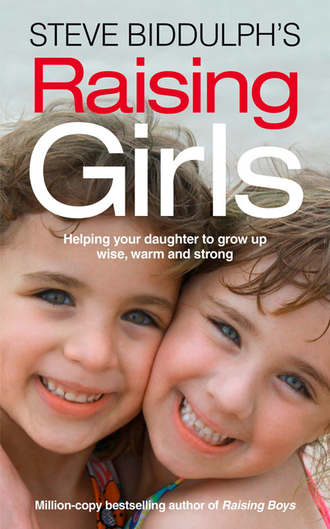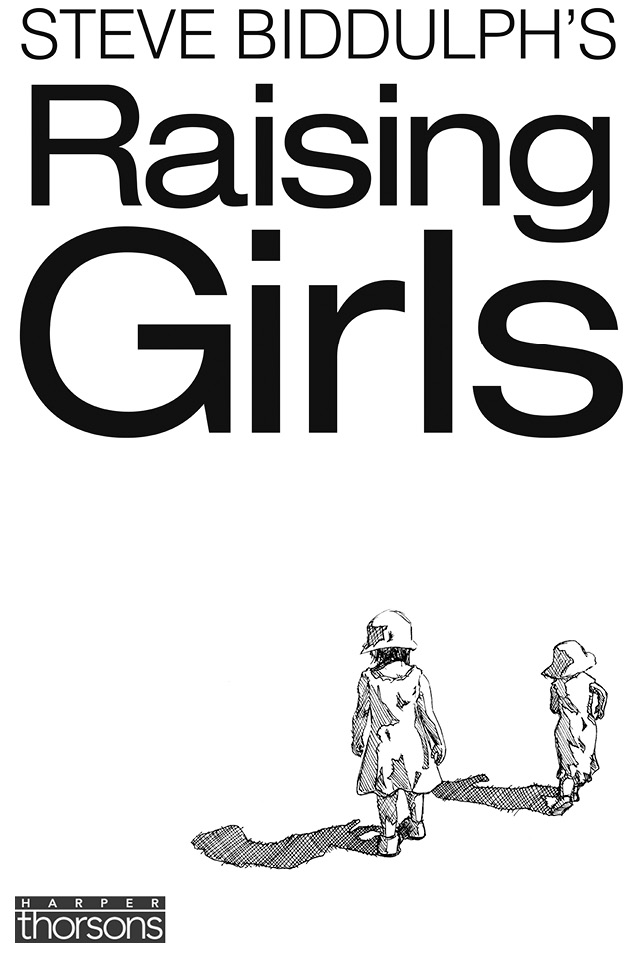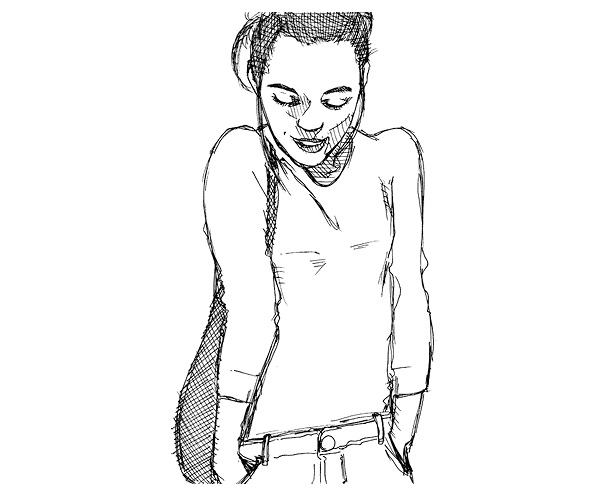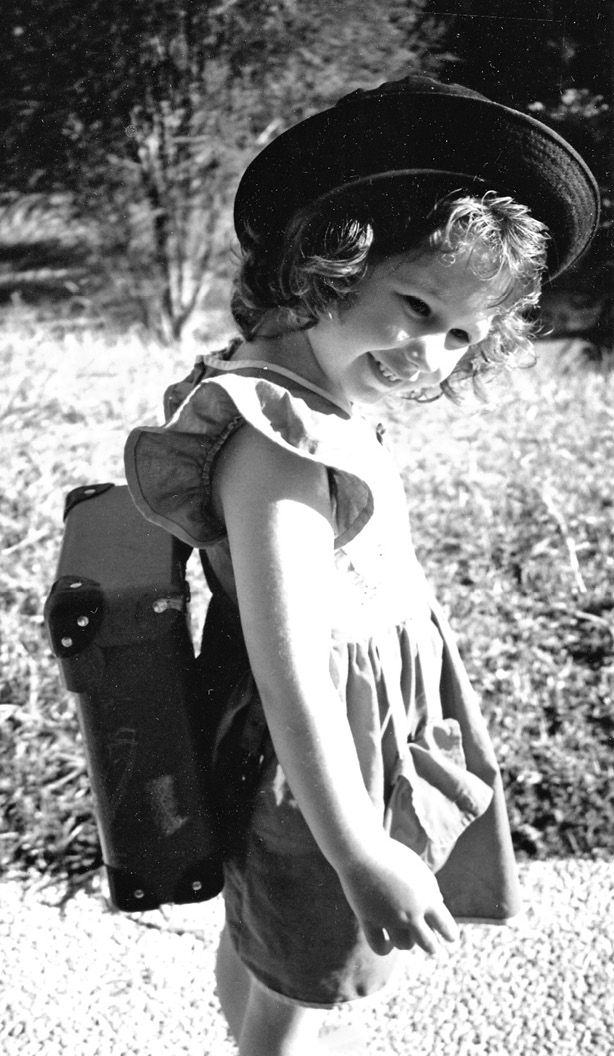
Полная версия
Steve Biddulph’s Raising Girls


Also by Steve Biddulph
Raising Boys
The Secret of Happy Children
Manhood
Raising Babies
Contents
Cover
Title Page
Also by Steve Biddulph
A Letter from Steve
Meet Kaycee and Genevieve
Part One: The Five Stages of Girlhood
1 Creating a Total Girl
2 Right from the Start (Birth–2 years)
3 Learning to Explore (2–5 years)
4 Getting Along with Others (5–10 years)
5 Finding Her Soul (10–14 years)
6 Preparing for Adulthood (14–18 years)
Part Two: Hazards and Helps: The Five Big Risk Areas and How to Navigate Them
7 Too Sexy Too Soon
8 Mean Girls
9 Bodies, Weight and Food
10 Alcohol and Other Drugs
11 Girls and the Online World
Part Three: Girls and Their Parents
12 Girls and Their Mums
13 Girls and Their Dads
What Happened to Kaycee?
Postscript
Notes
Contributors and Acknowledgements
Copyright
About the Publisher
A Letter from Steve
Dear Reader
Let me tell you a bit about myself before you jump into this book, so that you can know the person behind the words. People often think I must have boys, because I wrote and campaigned about boys for many years. In fact our first child was a boy (a man now). When our friends asked what we wanted next, I said I didn’t mind, and I really believed that was true. But when our daughter was born – by emergency caesarean, with me in the theatre trying my best not to faint – I was overjoyed. I couldn’t believe how happy I was. That happiness has never gone away.

I wrote about boys for just one reason – they were a disaster area, and the ethic of my work is to go where the need is greatest. Back in those days, girls were doing just fine. But about five years ago that started to change. We began to see a sudden and marked plunge in girls’ mental health. Problems such as eating disorders and self-harm, which once had been extremely rare, were now happening in every classroom and every street. But more than this, the average girl was stressed and depressed in a way we hadn’t seen before.
Girls aren’t born hating their bodies. They aren’t born hating their lives. Something was happening that was poisoning girls’ spirits. It seemed to come on in the early teens, but was creeping younger and younger every year.
In response, a worldwide movement sprang up – of girl advocates, therapists and researchers – to try and mobilise parents and the community. Many of these people were my friends, and together we saw the need for a simple, parent-friendly book to help get girlhood back on track. That is the book you now hold in your hands.
Raising strong girls starts young. We have to love them well, and we have to fight the forces that would bring them down. We have to make good choices because the world today does not seem to care about girls as it should, and sees them just as a way to make money. Of course some of these things are timeless. Girls have always needed to be strong.
Girlhood is a quest, a journey of gathering the wisdom needed to be a woman. We are our daughters’ guides on that quest. To do this we need good maps, good examples, and good clear eyes.
Perhaps your daughter is just a little baby. Perhaps she is in her teens. Whatever age, I hope this book lifts you up, fills you with a fire to make the world a better place for her and for all girls. And helps you to give her all the love you feel.
Sincerely,
Steve Biddulph
Meet Kaycee and Genevieve
There are two girls that I would like you to meet. Their names are Kaycee and Genevieve. Both are 17, and both are in Year 12 at school. They are great kids, friendly and bright, you would enjoy talking to them.
These two have known each other since nursery. They were best friends all through primary school and everyone thought they would be that way forever. But around the time Kaycee and Genevieve moved up to secondary school, something went wrong between them. The reason is hard to say, I am not sure they could even pin it down themselves, but today, if they pass in the school corridor, there is that awkward feeling that comes from having once been friends, but no longer being so.
Kaycee and Genevieve’s lives have taken very different paths. I’m going to tell you their stories, because they make really clear the dangers, and the hopes, of girlhood today.
Kaycee’s Story
Let’s meet Kaycee first. On first impression Kaycee seems a very grown-up 17-year-old. She wears carefully applied make-up and ultra-fashionable clothes, and she speaks fast and in a clear voice. This much confidence in a teenager may be quite genuine, but if you know young people well, you might wonder if Kaycee has possibly become ‘too old too soon’. And there is something else that you might notice. It’s in her manner. Her expression is world-weary. When she speaks she sounds rather cynical and hard. For a 17-year-old, she doesn’t seem to be having a lot of fun.
Back when Kaycee was 14, something big did happen. It wasn’t the stuff of newspaper headlines, but it was a significant experience that affected the direction of her life.

Halfway through Year 9, Kaycee was invited to a classmate’s birthday party. The parents hosting the party had implied a somewhat higher level of supervision than they actually provided on the night. So the party went pretty much as it would if 40 or 50 kids of varying ages were left in a house at night with lots of alcohol and no adults in sight: loud, chaotic and out of control. Kaycee found it very exciting; in particular because a boy whom she knew, Ciaran, aged 17 and two years above her in school, was there. Kaycee and her friends had often admired Ciaran at school, with his good looks and cool demeanour, but tonight there was something different – he was noticing her. Then, amazingly, it got better still. He sat with her, and they talked and had a few drinks. They talked and snuggled a little in the garden. She could hardly believe her luck (it was all she could manage not to take out her phone and text someone!). After a while, Ciaran stood up, took her by the hand and led her upstairs to one of the many bedrooms in this big, fancy house apparently devoid of adults. They had sex.
It all went faster than Kaycee had imagined her first sexual experience would, and it was less tender too. Blurred by the alcohol, Kaycee’s brain wasn’t really working very well; she was aware though of the shift from the excited feeling of being special and the centre of Ciaran’s attention, to physical discomfort and a sense of being pushed about, invaded, not really noticed as a person. When it was over, which was quite soon, Ciaran managed a kiss before straightening his clothes and leaving the room. When Kaycee got herself together and went out into the party, she felt unsure and shaky. Then she saw Ciaran, standing with a group of friends, who all looked at her and smirked. She realised in an instant that he had been telling them of his ‘conquest’. Tears burned her face, she fled from the house and ended up in the garden, sobbing. A friend tried to comfort her, but Kaycee wouldn’t say what had happened.
She went home that night in a kind of icy rage. She hated Ciaran now, and for a while boys in general. Kaycee was a spirited girl, she had been independent all her life, her busy parents valued self-sufficiency. She told no one what had happened. (When her parents finally learned about it three years later in a family counselling session, they were saddened and shocked.) But like millions of girls before her who had first sexual experiences they regretted or did not enjoy, Kaycee hid her wounds and got on with her life. But she was a changed girl.
Did the experience put her off boys? Not at all. What it put her off was vulnerability, being the one who was used. She began sleeping with boys on her own initiative, and on her own terms. She chose them, and she called the shots. By the age of 17, when she first spoke to a counsellor, Kaycee had had sex with seven different boys. Possibly eight, there was a night where some alcohol-affected confusion had occurred, and she wasn’t sure.
Now, in Year 12, Kaycee has stabilised somewhat, she has a steady boyfriend. But she doesn’t hold him in very high regard, and confides that she is ‘planning to ditch him sometime soon’.
We know from research, (and from most people’s recollections of their own teenage years), that Kaycee’s experience is not uncommon. Perhaps, one could argue, we just need to be less uptight about teen sex and let them make their own mistakes, and learn from them. (That is also a convenient argument for those parents who prefer not to get involved, or are too busy to keep a close eye on their kids.) But let’s stay with the story …
Kaycee’s life, at this point in time, isn’t going very well. Her parents sought help not because of her sex life, which they were only vaguely aware of, and in a sense didn’t want to know about. Their concern was that her drinking was getting out of control (she was not yet, of course, of drinking age) and she was failing at her expensive private school. She was halfway through Year 12 and the school was concerned about her poor marks and her many absences from class. The family had been advised to ‘see someone’ about her problems. When she arrived with her parents to meet with a counsellor, Kaycee looked angry to have been brought there. But within half an hour, and given a sympathetic listener, she was pouring out her feelings.
The family’s seeking help – not just for Kaycee, but for themselves – was a brave step, and in fact proved to be a turning point. We will return to Kaycee and her parents at the very end of the book, to let you know how it all worked out.
A Marked and Sudden Change
In the last ten years there has been a big change in the lives of girls. And it’s affecting them at every age, from babyhood to teens. While the same wishes and dreams are there for girls journeying towards womanhood that we had in our day, the world is forcing changes on them that are on a whole different scale. In particular, things are beginning to happen when they are younger.
This is a key point to keep in mind about girls’ situation today, and it was first made by Maggie Hamilton in her book What’s Happening to Our Girls? To understand our daughters, we have to realise that their childhood is not like ours. To put it bluntly, our 18 is their 14. Our 14 is their ten. That’s in terms of the pressures, the behaviours, and what they are supposed to be, and act like, according to the peer norms that exist today – and our failure to protect them, for we are partly responsible. We – and that’s all of us, parents, relatives, friends and society – are not supporting girlhood in the way we once did. We haven’t put enough adult time and care around our daughters, or taught them well enough.
In the last ten years a greedy corporate world has realised that girls, and especially pre-teen girls, are a soft target. Companies saw that there were enormous profits to be made in exploiting their anxieties (or in fact creating those anxieties) about everything from skin to weight to friendship to clothes to even making it into adulthood. In boardrooms and advertising agencies, magazines and media outlets, the war on girls began. And it succeeded. Everywhere she looks, today’s young girl sees messages that make her feel she is not good enough, that imprison her in cramped and narrow ideas of how she is supposed to look, think and act. Never before has girlhood been under such a sustained assault, ranging through everything from diet ads, alcohol marketing, fashion pressures, to the inroads of hard pornography into teenage bedrooms.
The result is that many girls have lost four years of childhood peace and development. They are being forced out of childhood when they have not yet completed it, or even fully enjoyed it. The result is girls in enormous pain and confusion. They try to act grown-up but they can’t. They are filling up the mental health clinics, the police stations and emergency rooms, the alcohol and drug treatment programmes in numbers never seen before.1
If we are awake to what is going on, we can prevent this. Partly it’s through the love we give, partly the environment we create for them with support and interests, and partly the protection from the stupid and exploitive media messages from the world around them. I have a favourite saying that has often helped me: ‘We can’t stop the birds of sorrow from flying through our lives, but we don’t have to let them make nests in our hair!’ We can live in this world, but we don’t have to swallow everything it offers us. We can choose for ourselves and for our daughters the experiences that make us strong, happy and alive. That’s what Genevieve and her parents did …
Genevieve’s Story
Genevieve, like Kaycee, is also 17, also in Year 12. On first meeting, Genevieve seems a little nervous and shy, but she soon relaxes when she gets to know you. Her conversation is full of ideas, concerns and funny stories and perspectives on things. She switches in a moment from excited child to thoughtful young adult, as is typical of someone just on the edge of womanhood. She doesn’t have the tough exterior of Kaycee, but then, perhaps she doesn’t need to. Her story is a very different one.
Genevieve does not have a boyfriend right now. She would love to, but is wary; she knows that young love is not always easy. Also, she finds the boys of her own age frustratingly hard to hold a conversation with, and longs to meet more mature, communicative boys when she goes to university.
Genevieve’s friends at school are a warm and friendly bunch, not the high flyers, but the quieter, more natural kids. They look out for each other and also, if there is a newcomer or someone left on the outer edges of the group, they are more likely to include them and make them welcome. As a result, they are a large, ramshackle group, slightly dorky and uncool but not too worried about it.
Genevieve did go out with a boy at 15, and this was an intense experience for her. Justin was her own age and they met early in the school year. They spent time together as often as they could, taking long walks, holding hands, having soulful conversations. He was more experienced sexually, though, and after a few months, began pressuring Genevieve to ‘go further’ when they were alone together. Other girls had had sex with him in the past and he really wanted this with Genevieve too.

Genevieve is close to her mother, and accustomed to talking over pretty much everything in her life with her. In fact, her mother joked that for every hour spent with Justin, Genevieve spent another hour discussing what had taken place, what he said, what it might mean, what she said back, and so on! While many girls do this detailed debriefing with their friends, Genevieve was used to discussing her innermost thoughts with her mum, and so this new problem naturally became part of their ongoing conversation. As a result, her mum was involved in dealing with this new sexual pressure on her daughter, and able to offer her help.
To her great credit, Genevieve’s mum did not panic, and did not try to take control of the situation by telling Genevieve what to do. She later told me that she would, if necessary, have brought in some limits on how and where the pair could meet, since they were below the legal age, as well as the wise age, to start having sex. In other words, she would not allow her daughter, at just 15, to be out of her depth in a situation where she might not be emotionally and physically safe. At the same time, Genevieve’s mum supported, cautiously, her wish to have a friendship with a boy. She would drive her daughter into town to meet Justin to go to a movie or meet up with friends, or bring him over to visit their house.
This remarkably sensible mother had a low-key but thoughtful response to her daughter’s questions. Instead of ‘laying down the law’ as a first strategy, she simply helped Genevieve to explore her own wants. What did she feel she wanted? What was her body telling her? What did she think was the course of action she would feel good about, long term?
She did this in a quiet, casual kind of way that gave Genevieve real space to reflect. Her mum had that knack of listening intently without pressure, so that Genevieve knew that she had her full attention, and so her thoughts and feelings tumbled out effortlessly.
Genevieve’s inner signals were quite clear. She really liked Justin, she liked being with him, but she felt uneasy and rather crowded when he was too physical with her. It was all a bit too intense. She hoped their relationship would strengthen and grow, but she wanted it to take its time. Her mother listened, and nodded, and reflected back to her daughter, ‘It sounds like you really aren’t ready to have sex with him, you don’t want it to go that way right away?’ Genevieve said no, but she was worried what would happen if she rejected Justin’s advances repeatedly. They talked over how she could let Justin know her feelings and wants.
Over the next few weeks, Genevieve and Justin did have a kind of debate about this. He basically gave his own ultimatum, in response to hers, and there was a real testing of wills. Justin knew plenty of girls who, though not quite as interesting or special as Genevieve, were willing to offer him sex, and in the end, he ‘walked’. Genevieve had known this was a real possibility, but that did not prevent her from feeling crushed. She was an open-hearted girl, almost totally without hardness or shell, and she took a long time to heal. But she did heal, and six months later, when Justin phoned to try to get back together, she was kind but clear in her refusal. She had moved on.
A Reality Check
When I was young I loved to travel and live in remote places. From tiny villages in Papua New Guinea to the slums of Calcutta in West Bengal. When I returned home, I was always struck by this remarkable thing: people living in tough places were happier. Life in these places was hard, but the locals still managed to laugh and be warm to each other. (When I came back to affluence, everyone seemed miserable.) The experience convinced me: we are supposed to be happy. We are not meant to be depressed. Especially not at 15 years of age.
Girlhood is supposed to be fun, with friends young and old, adventures in young love, mastery of new skills and abilities. Its dramas should be dramas of learning and growing, not being battered and damaged.
Compared to how girlhood should be, it’s clear something has gone badly wrong. Millions of parents are asking, why are our daughters so stressed? What should we do, so that their lives turn out well? As you will soon see, there is plenty that we can do.


Chapter 1
Creating a Total Girl
Two-year-old Mollie lifts a Tonka truck high in the air and is about to smack it down on her friend Jemima’s head. Even at two, she knows this is not really in the True Spirit of Playgroup, so she glances towards where her mother is watching to see how it might go down. Her mum has seen it all and is urgently flashing her a ‘don’t you dare’ frown. Ever … so … slowly, Mollie lowers the truck to the carpet and goes back to crayoning. Jemima remains blissfully unaware that anything has happened and goes on humming to herself while holding firmly onto the only yellow crayon.
Ten-year-old Elise looks at her computer screen, and sees the message bagging one of the girls in her class, a girl who is already shy and insecure. It’s mean and personal, and one of her own friends just posted it. Elise chews her top lip so hard it leaves a red mark. She hates bullying, but how can she intervene and not make enemies? She heads downstairs to talk to her mum.
Fifteen-year-old Samantha pauses during the maths exam, draws a deep breath and frowns. She has almost finished, with loads of time to spare. If she keeps going, she will probably top the class; she likes maths and always does well, but then she will be seen as a ‘brain’, which is highly uncool, especially with boys. She knows she can just stop now and leave out the last couple of questions. Nah! she exclaims to herself, then worries if she said that out loud? Nobody seems to have noticed. She gets on and finishes the exam.
Girlhood is a lot of fun, for parents and for girls themselves, but it also has its intense times. At each stage of their growing up girls have to deal with difficult decisions. They get confused and make mistakes, but eventually they learn and grow, and out of all this they become capable and strong adult women.
For you as their parent, it helps to have a map of the country of childhood, so that you know what to expect and what to do. The map in this book is drawn from the latest findings in child development and neuroscience, family therapy and parenting education, but it also comes from talking to mothers, fathers and teachers in many countries. I never quite trust experts, unless what they say matches my own heart and passes the test of common sense. That comes from talking to lots of people. Eventually, the map becomes clearer. You feel like you know where you are.







